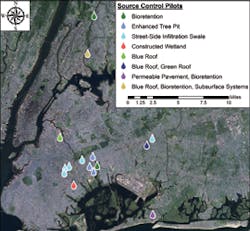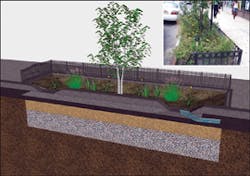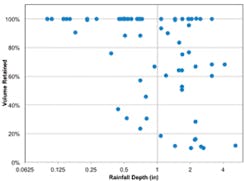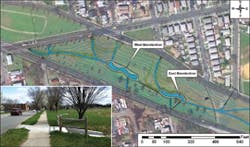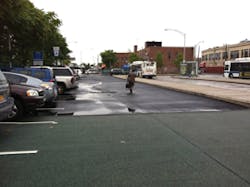Stormwater Source Control in New York City
As the largest urban area in the United States, New York City (NYC), NY, faces substantial challenges in managing stormwater runoff. As with many other older cities, much of NYC is served by a combined sewer system, which conveys both stormwater and wastewater, to wastewater treatment plants. Although these plants are generally designed to manage twice their dry-weather flow, during prolonged or intense storm events, the design capacity of these treatment plants can be exceeded. At these times, combined sewer overflows (CSOs) alleviate excess flows by discharging combined stormwater and wastewater to receiving waters, which poses a threat to water quality in NYC’s rivers and bays.
Currently, there are more than 450 CSO outfalls distributed throughout New York City. The city has been making efforts to reduce CSOs for many years through a variety of approaches including treatment plant upgrades, maximizing the wet-weather flow that is conveyed and treated at the treatment plants, improved CSO regulators, inline storage, and other storage and detention options. Recently, the city has undertaken an innovative initiative to supplement these activities with green infrastructure in order to better manage stormwater runoff. Using natural processes such as infiltration and evapotranspiration, as well as rainwater recycling, green infrastructure source controls reduce and delay the flow of stormwater to the combined sewer system. Collectively, implementation of green infrastructure is expected to alleviate pressure on combined sewer infrastructure and reduce CSOs. Unlike some grey infrastructure approaches, green infrastructure is recognized as a strategy that not only manages stormwater runoff but also can improve quality of life through increased shading, improved air quality, increased property values, and improved urban aesthetics, among other benefits. The implementation of green infrastructure has become a critical aspect of the NYC Department of Environmental Protection’s (DEP’s) efforts to address combined sewer overflows within the city, with plans to use green infrastructure to manage runoff from 10% of impervious surfaces within combined sewer areas by 2030.
While the natural elements of green infrastructure can provide a wide array of benefits, they also involve a degree of variability and uncertainty, especially in an ultra-urban environment. To better understand the functionality of green infrastructure source controls within NYC, DEP has developed a green infrastructure pilot study. The intent of this pilot study is to evaluate the use of green infrastructure source controls throughout New York City, gaining a better understanding of the overall issues associated with implementation, including challenges during planning, design, construction, and maintenance, as well as identifying and quantifying the benefits these source controls provide. This pilot study serves as a foundational element for the adaptive management strategy NYC is utilizing for the implementation of green infrastructure throughout the city.
The green infrastructure pilot study is one part of DEP’s larger green infrastructure implementation efforts. DEP has also created an interagency Green Infrastructure Task Force responsible for identifying opportunities to incorporate green infrastructure elements into capital projects, created an Office of Green Infrastructure within DEP, launched a Green Infrastructure Grant Program, developed standard designs for green infrastructure, signed a memorandum of agreement for the maintenance of green infrastructure, and facilitated the creation of a Green Infrastructure Steering Committee.
Pilot Planning and Implementation
Through the green infrastructure pilot study, a variety of stormwater source controls were implemented at locations throughout NYC. Bioretention, street-side bioswales, blue roofs, green roofs, permeable pavement, and subsurface detention and infiltration systems were among the practices incorporated for study. All pilots were constructed on public property within combined sewer areas across New York City. Implementation focused predominantly on the Bronx, Queens, and Brooklyn, as these boroughs contain high priority areas for CSO management (Figure 1). Staten Island was not a focus, as much of the island is served by a separate sewer system, with a large portion of runoff managed through natural-based systems as part of the Staten Island Bluebelt program. Likewise, Manhattan was not targeted, as the prevalence of subsurface structures, including utilities, vaults, and subway tunnels, complicates the feasibility of using green infrastructure source controls reliant upon infiltration. Rooftop controls piloted in the other boroughs will likely be more suitable for application in Manhattan.
Pilot locations were selected to represent a range of potential future implementation sites within the city, including along streets, on rooftops, within parks, within public housing facilities, and within parking lots. These public properties contain various configurations of impervious surfaces, are controlled and maintained by different agencies within the city, and provide unique challenges and benefits. As most of NYC has been developed, all of the pilots were constructed as retrofits.
Streets and adjacent sidewalks are of interest for stormwater management, as these surfaces cover more than one-quarter of the total land area within some neighborhoods of New York City. Furthermore, these impervious surfaces are often contiguous, with runoff flowing along curb lines until it is collected by catch basins, often located at street intersections. This configuration, plus public ownership, presents advantageous opportunities for green infrastructure implementation within street rights of way. Street-side bioswales are currently the predominant source control used to manage stormwater runoff from these areas.
Rooftops are another practical location for green infrastructure. On some blocks within the city, rooftops can make up the majority of impervious surfaces, presenting opportunities for stormwater management directly at the source. Rooftops are generally unused space with limited public access and are especially valuable for stormwater management in areas where ground-level space for source controls is limited. Blue roofs and green roofs were both implemented on rooftops as part of the green infrastructure pilot program. Blue roofs consist of structures that detain water directly on the rooftop. Various configurations, including modified inlets, check dams, and trays, are being evaluated through the pilot program. Green roofs also manage runoff directly on the rooftop, but incorporate a greater focus on retention and evapotranspiration through the use of an engineered soil media and vegetation.
Parks, public housing facilities, and parking areas distributed throughout the boroughs also present opportunities for stormwater management on public property. These properties offered chances for implementation of a variety of green infrastructure source controls including bioswales, larger bioretention installations, rooftop practices, permeable pavement, and subsurface detention and infiltration systems.
Implementing stormwater retrofits can present obstacles in any area; however, when implementing green infrastructure source control retrofits in an ultra-urban area like New York City, there are some unique challenges and benefits. As previously mentioned, pilot green infrastructure implementation focused on public properties within the city. These locations were selected to facilitate coordination during the planning and design process, as well as maintenance of source controls after construction was completed. In order to garner stakeholder support, it was important to select source control types and locations that would not interfere with existing facility uses, which was accomplished by modifying existing landscaped areas to serve as bioretention, or installing subsurface systems below parking lots, among other approaches. Where possible, green infrastructure was implemented in areas where it could improve existing conditions, either by improving aesthetics, alleviating existing drainage problems, or improving the existing infrastructure, such as repaving parking lots. In addition to improving stormwater management and providing multiple benefits, these aspects often helped to garner agency owner and community support for green infrastructure.
As with any type of stormwater control in an urban area, planning for effective maintenance was an important consideration during the design in order to better ensure long-term success. A variety of mechanisms were incorporated into the source control designs in an effort to maximize long-term performance while minimizing the effort required to conduct routine maintenance. Such measures included installing pretreatment chambers for subsurface systems, installing sumps immediately downstream of curb cuts to isolate litter and debris collection activities, and generally utilizing catch basins and other structures that were familiar to city maintenance staffs.
Stormwater Pilot Monitoring
Apart from gaining experience with the planning, design, and construction of the pilot green infrastructure source controls, a major component of the pilot program is evaluation of source control performance and logistics on the ground. A multifaceted monitoring program was implemented to better understand the functionality of these source controls, guiding future planning, design, and implementation efforts.
Understanding the effect of source controls on storm hydrology and hydraulics is a key element of the green infrastructure adaptive management approach being used within New York City. Green infrastructure source controls typically detain and retain stormwater runoff, both of which can have an impact on the downstream combined sewer system. To better characterize the effect of green infrastructure implementation on the combined sewer system and CSOs, it was important to understand not only the magnitude of runoff detention and retention, but also aspects related to storm timing and consideration across a range of storm characteristics. Because rainfall patterns, soil conditions, and other aspects related to green infrastructure performance vary throughout the city, it was also important to evaluate pilot performance at a range of locations.
To better understand these issues, a monitoring program was developed that relies predominantly upon
remote monitoring equipment to evaluate quantitative source control performance over a two-year period. Although monitoring setups vary for individual sites, inflow and outflow rates are frequently measured. Flow monitoring setups generally consist of a pressure transducer water-level logger installed upstream of a weir or flume. Flow monitoring is used to evaluate the effect of source controls on runoff rates and volumes across an array of storm characteristics. At some sites, water-level loggers are installed on the surface or within subsurface storage layers to evaluate runoff storage within the systems, drawdown rates, and other similar aspects of source control performance. Rain gauges or more comprehensive weather stations are frequently installed within the vicinity of pilot source controls to better understand source control performance, as well as general rainfall patterns across the city.
Onsite testing and calibration is an important element of the overall monitoring program. Water discharged from fire hydrants through flow meters was used to provide a known flow rate through inlet and outlet flow monitoring devices to test whether the flow monitoring equipment was functioning as intended, identify any equipment maintenance needs, and provide in-field calibration of the equipment. In some cases, onsite calibration yielded substantially different results from literature values or lab-calibrated measurements, indicating the importance of the onsite testing.
In addition to quantitative source control monitoring, qualitative evaluations regarding elements such as the success of vegetation, community perception, and maintenance needs are being performed to provide crucial information for future implementation efforts. Qualitative evaluations are generally conducted during routine site visits to download and maintain monitoring equipment. Evaluations of maintenance needs are of particular importance, and consider everything from erosion repairs and litter removal to addressing vandalism.
Preliminary Observations
Stormwater pilot source control monitoring began at a number of sites throughout New York City during the spring of 2011. While monitoring activities are expected to continue through at least 2012, evaluation of 2011 monitoring data yielded a number of interesting preliminary observations. These findings are expected to be validated and expanded upon through further monitoring efforts.
Enhanced Tree Pits and Street-Side Infiltration Swales. During the 2011 monitoring period, eight
enhanced tree pits and street-side infiltration swales were evaluated throughout Brooklyn and Queens; these constituted the first fully permitted, first-generation green infrastructure installations within New York City. Both of these system types were adapted from bioswale designs and installed within the sidewalk immediately adjacent to the roadway. The enhanced tree pits consist of an inlet and outlet curb cut, a shallow surface depression, several feet of engineered sandy soil, and several feet of crushed glass or stone, as shown in Figure 2. The enhanced tree pits are generally 20 feet long by 5 feet wide. The street-side infiltration swales are similar in design, but generally are 40 feet in length and use engineered sandy soil throughout their full depth, rather than a crushed glass or stone layer. These systems function by diverting runoff from the roadway into the source control, where it can be utilized by plants, stored within the soil and stone layers, or seep from the bottom of the system. Generally, these enhanced tree pits and street-side infiltration swales receive runoff from drainage areas between 2,000 and 6,000 square feet.
Monitoring results indicated that these source controls were frequently able to retain runoff from storm events with 1 inch of rain or less (Figure 3). As there were no underdrain systems, all runoff that did not overflow or bypass along the curb was retained. Furthermore, results from early monitoring efforts (not shown here), in conjunction with onsite evaluations, illustrated the importance of effective curb cut designs. Initial curb cuts had a closed frame structure to maximize consistency with existing curb lines; however, these curb cuts were frequently blocked by litter and other debris, hindering source control performance. Installation of open curb cuts greatly improved runoff capture performance. Subsequent bioswale designs incorporated not only was an open curb cut but also a depressed concrete apron around the curb cut, further improving runoff capture efficiency.
North and South Conduit Avenues Bioretention. Another bioretention pilot site built in the fall of 2011 is a pair of bioretention areas within a highway median between North and South Conduit Avenues in Queens, NY (Figure 4). These bioretention areas receive runoff from nearly 82,000 square feet of impervious area, in addition to pervious contributions within the median. The vertical profile of the bioretention areas consists of a 6-inch surface depression, 2 feet of sandy engineered soil media, and a 1-foot stone drainage layer. An underdrain system connects the subsurface storage layers, while an overflow channel hydraulically connects the bioretention surface storage during large storm events. A single overflow grate structure in the eastern area combines surface overflow with underdrain outflow and conveys that water to the downstream sewer system. A stop log structure installed along this flow path is used to measure outflow rates while also restricting outflow from the system. The stop log requires water to pond to an approximate depth of 2 feet within the bioretention subsurface layers before flowing to the downstream sewer system. Runoff was diverted from surrounding sidewalks and streets through the use of various curb cut designs, as well as installation of new catch basins and modification of existing catch basins.
Design activities at this site illustrated the high level of required coordination when implementing green infrastructure in an ultra-urban setting. Onsite, the existing drainage and sewer infrastructure is controlled and maintained by the DEP’s Bureau of Water and Sewer Operations. The median itself is controlled by the city’s Department of Parks and Recreation, but maintained by the city’s Department of Transportation. Detailed coordination was needed with all of these parties to ensure that existing sewer infrastructure was not negatively impacted, trees within the median were preserved, and grass and other areas within the median could be appropriately maintained.
During the 2011 monitoring period, runoff was fully retained for all storm events less than 2 inches. The median time required to drain the surface after a storm event was seven hours. Monitoring evaluations and onsite tests demonstrated that conveyance swales within the median were providing runoff retention benefits, while curb cuts were not fully effective at capturing roadway runoff. Further investigation of these issues is ongoing.
Bronx River Houses: Bioretention. A combination of green infrastructure source controls was implemented at the Bronx River Houses public housing complex, located in the Bronx, NY. Bioretention, a blue roof, a subsurface stormwater chamber system, and a subsurface perforated pipe system were all implemented at this site.
Five bioretention areas were installed within existing grassed areas around the central community center (Figure 5). In total, these bioretention areas manage runoff from approximately 18,500 square feet of impermeable sidewalk. To conform to existing site constraints, the bioretention areas were generally installed with a 6-inch surface depression, 12-inch engineered soil layer, and 8-inch stone drainage layer. Runoff is diverted into the bioretention areas using curb cuts, which incorporate flagstone flumes and sumps immediately downstream to reduce erosion potential and facilitate litter and debris collection. These bioretention areas include underdrain pipes within the stone drainage layer that drain to existing catch basins onsite.
Most bioretention areas exhibited little or no measurable outflow for smaller storm events during the 2011 monitoring period. While there were variations in the performance of individual bioretention areas, likely attributed to differences in contributing drainage areas, these source controls generally retained 80 to 100% of storms smaller than 1 inch, even with an unrestricted underdrain system (Figure 6). Detailed evaluations of pilot performance suggest that runoff was detained at the surface and within the bioretention soil, subsequently seeping into the underlying soil. Even with surface detention, the bioretention areas drained relatively rapidly. With a median surface drawdown duration of five minutes, the bioretention surface frequently drained before a storm event ended.
Bronx River Houses: Subsurface Systems. Subsurface detention and infiltration systems were also installed under existing parking lots at the Bronx River Houses complex. A stormwater chamber system receives runoff from nearly 4,000 square feet of impervious parking area, while a perforated pipe system receives runoff from more than 13,000 square feet of impervious parking area and surrounding sidewalks. Both of these systems incorporate a baffle structure for pretreatment and contain a restrictive orifice plate on the downstream end. These systems were designed to comply with DEP’s new stormwater performance standard, which limits peak discharges to 0.25 cubic foot per second during a 10-year storm at these sites. Although runoff detention is the primary intended role of these facilities, they were designed and constructed with an open bottom in contact with in-situ soil to encourage infiltration losses.
Despite a design that focused on detention, the open-bottom stormwater chamber system was able to fully retain stormwater runoff for most storm events. Measurable outflow only occurred during large or intense storms. During events that generated outflow, measurable outflow generally ceased while runoff inflow was still being measured, indicating seepage losses affected overall source control performance. Because runoff was diverted from a retrofitted existing catch basin, there was no evidence of flow bypass similar to what was observed at some of the source controls with curb cuts. Preliminary observations were not available for the 2011 monitoring period at the perforated pipe system due to later construction and ongoing evaluations at that facility.
Far Rockaway Permeable Pavement. Within the Far Rockaway section of Queens, permeable pavement was installed within a DOT park-and-ride facility. This source control pilot consists of a porous asphalt section, a permeable pavement section constructed from crushed glass, and a standard asphalt section for comparison purposes (Figure 7). The porous asphalt and crushed glass pavement cover approximately 6,400 square feet and 4,200 square feet, respectively. The permeable pavement sections did not generate measureable underdrain outflow during the 2011 monitoring period, suggesting that subsurface stone storage and underlying soil infiltration rates were significant contributors to retention. During 2011, surface runoff from the permeable pavement sections was not monitored; however, onsite testing suggested small amounts of surface runoff may have been generated by the porous asphalt section during intense storm events. Additional monitoring equipment has been installed since to quantify any surface runoff during the remainder of monitoring activities at this site.
Additional Monitoring Activities. Additional implementation and monitoring of source control pilots is underway throughout New York City. Beyond the pilots discussed here, blue and green roof facilities throughout the city, a series of bioretention areas installed within an existing park and DOT park-and-ride facility, and a stormwater wetland installed along the edge of a parking lot are being monitored. Furthermore, widespread implementation of green infrastructure within localized priority sewersheds is underway to evaluate the effect of green infrastructure implementation on overall sewer flows.
Preliminary Conclusions
Within New York City, there are opportunities to manage stormwater runoff by implementing a range of green infrastructure source controls within various types of public properties. The New York City green infrastructure pilot program has illustrated that green infrastructure can provide an array of benefits, but implementation is not without challenges. Within an ultra-urban area like NYC, careful planning, design, and implementation efforts are needed to ensure green infrastructure implementation is effective, addressing everything from site constraints and maintenance considerations to public perception and involvement.
Quantitative pilot monitoring activities illustrate that substantial retention of stormwater runoff is possible,
even in one of the largest and most densely developed urban areas in the Unites States. In fact, many of the green infrastructure source controls monitored to date only discharged flow to the sewer system during large or intense storm events, alleviating pressure on the downstream sewer system. It is important to note that although informative, preliminary observations discussed here are not a definitive evaluation of green infrastructure performance, and monitoring and analysis efforts are ongoing. Beyond revising or substantiating preliminary findings, additional data collection and analysis are expected to provide a more comprehensive evaluation of the effect green infrastructure can have on sewer flows and ultimately on combined sewer overflows.
The green infrastructure pilot program is a fundamental element of DEP’s adaptive management approach to use green infrastructure to manage stormwater runoff and reduce CSOs. By implementing source controls throughout the city, it will be possible to better manage stormwater runoff while also providing an array of additional benefits. Ongoing evaluations of green infrastructure implementation throughout the city are providing real information on the benefits of these systems, as well as the variety of issues affecting implementation. In total, these evaluations are expected to help refine design and planning efforts so that green infrastructure can be implemented in areas and configurations that provide optimal benefits, ultimately supporting a greener and greater New York City.
Acknowledgements The joint venture of Hazen and Sawyer, HDR-HydroQual, and Biohabitats is performing the work discussed herein for the New York City Department of Environmental Protection, with support from the Horsley Witten Group and Geosyntec and in collaboration with Brooklyn College.